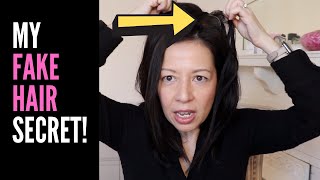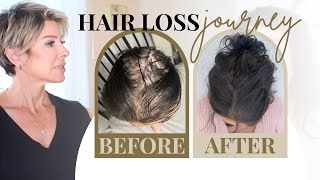Wigs for Cancer Patients | Chemo Wigs
- Posted on 18 October, 2016
- Hot Topic
- By The Wig Company
Your guide to managing hair loss during chemotherapy, and choosing the right alternative hair option for your needs.
Facing the reality of hair loss due to chemotherapy can be traumatic and stressful. An alternative hair option, such as wigs, wiglets, or toppers, can have a positive impact on meeting the daily challenges of cancer treatment. Serving women all over the world for 48 years, The Wig Company has specialized in alternative hair options since 1969. If you've never worn a wig, wiglet or fabric head cover, and are looking for information on alternative hair options for chemotherapy, this article will provide you with information and options to help you make informed decisions. We’ll guide you through must-know topics about cancer-related hair loss, as well as provide you with the best wig and headwear options for your specific needs.
Chemotherapy and Hair Loss
Beginning chemotherapy treatment can be a scary and destabilizing time. The anticipation of hair loss can be an added layer of anxiety for many women. Some cancer treatments are more likely to result in more hair loss than others and can range from mild thinning to complete baldness. Hair loss often begins after a few treatments. At that point, your hair may fall out slowly or in clumps. Be sure to talk with your doctor about whether or not your chemotherapy is likely to make you lose your hair before investing time, energy, and money in an alternative hair option. If you are experiencing localized hair loss or spot baldness, you might want to consider wearing a topper rather than a full wig.
Finding the Right Wig
When choosing a wig, comfort and subtle beauty are two characteristics that cancer patients will truly appreciate. Today, wigs are designed to be more comfortable and versatile than ever before. Open-frame capless construction wigs are specifically designed to keep the wig cool and light, allowing synthetic hair fibers to move freely, giving you more styling flexibility. These fibers are sewn onto thin strips of material, called wefts, which are attached to a lightweight elastic ribbon frame, creating a comfortable, airy cap. If you’re looking for a wig with a more natural-looking hairline, consider wearing a lace-front wig. Just remember to account for any physical changes (such as weight loss or skin tone changes) that may occur once treatment begins.
Synthetic vs. Human Hair Wigs
There are two types of wigs for cancer patients to consider. Those made from synthetic fibers, and those made from human hair. Synthetic wigs are typically more affordable, typically priced between $40 and $400, while human hair wigs can run as high as several thousand dollars. If you have worn wigs prior to your medical treatments, and know the frequency and length of time you will be wearing a wig throughout the day, choosing the right kind of wig might be easier.
If this is your first experience with a wig, you might want to consider the less costly option, which is a synthetic fiber wig. While a human hair wig can provide you with the comfort and confidence of natural hair, it could result in a much higher maintenance routine compared to a pre-styled synthetic wig option. Keep in mind that fatigue can be a common side effect with chemotherapy and you might not want to spend your energy styling human hair. Below is a list of things to consider when choosing between the types of wigs:
Synthetic Wigs
Less expensive – one-tenth of the cost of a human hair wig.
Always come pre-styled and ready-to-wear.
High-quality synthetic fibers feel and look like natural hair without the need for costly salon restyling.
Easier care and maintenance than human hair wigs.
Style and color are unaffected by washing or environmental factors, like sunlight or humidity.
Human Hair Wigs
More expensive than a synthetic wig.
Functions like your own hair. It can be curled, straightened, and styled as you would your natural hair.
It can be custom cut and colored.
Can handle the heat from styling tools.
Wig Comfort Features
Over the years, wig comfort features have greatly improved, which is a definite benefit for cancer patients who are concerned about the comfort factor with wearing a wig on a daily basis. Below are several comfort features you should look for when considering a wig:
A lightweight wig. Capless wigs are a great option when looking for a lightweight wig.
A tension-easing circumference band, comfortable velvet lining (eases pressure between nape and ear), or discreet flexible combs (to hold the wig securely).
Wigs that accept double-sided adhesive wig and toupee tape.
Open ear tabs if you wear eyeglasses.
Thin wefts for lighter weight, improved airflow and breathability.
Soft monofilament cap construction for sensitive scalps.
A comfortable wig is just as important, if not more, than its style or aesthetic quality. There are a wide variety of celebrity brand wigs, such as Raquel Welch, Gabor, that are designed with many of the advanced comfort technology features mentioned above.
Wig Color and Skin Tone Changes
You may be looking for a wig that replicates the exact color of your natural hair. If this is the case, The Wig Company can help you achieve this with a free color matching consultation. Simply cut a sample of your hair from the front or top of your head. Make sure that it’s a fairly thick sample (about 1.5 inches long). Place your hair sample in a zip lock bag and mail it to us along with your contact information. Upon receipt, a trained color matching specialist will examine your hair color under professional lighting and will choose a wig color that best matches your natural hair. From there, the specialist can also assist with recommending a wig that is available in your specified color.
During cancer treatment, you may notice a change in your skin color, including yellowish, pale, blue-tinged, red, grey, or greenish tones. Selecting a wig that is a few shades lighter in color than your natural hair can help offset the appearance of this change.
Wig Alternatives
If you decide that a wig is not the right choice for you that's okay! Your comfort and self-confidence should be the guiding lights in your journey. There are a variety of wig alternatives for cancer patients. Even if you are interested in wearing a wig, headwear is an alternative that gives you the freedom to take the occasional, much-needed, “wig off day”.
Turbans, Cancer Scarves, and Tie-Backs
Turbans and scarves/tie-backs are popular with cancer patients because they help with comfort, versatility, and security. Most of these versatile products provide full head coverage, effectively concealing hair loss with a subtle, casual style. Most are made from extremely comfortable and breathable materials, such as bamboo viscose, cotton, and silken polyester. Turbans and scarves can be stylish, colorful, and fun – plus, they're easy to wear and wash, which is an advantage if you are experiencing a tiring day or a restless night.
Chemo Hats
Hats and caps are a great alternative if you’re looking for simplicity. Wearing a cute and comfortable hat is an option that can be especially useful in the early stages of hair loss.
The Wig Company Cares
Whether through a personal diagnosis or through the struggles of a friend or family member, many people are affected by cancer. The Wig Company is committed to making a difference in the lives of patients throughout the country. If you have a gently worn wig, please donate it to your local American Cancer Society chapter.
Beyond your medical care team, the caring professionals at The Wig Company pledge to be an invaluable resource for you. We will guide and advise you through every step of your alternative hair selection process, including choosing a style, size, or color. Once you've chosen your wig, your order will be expedited and shipped the very same day. Here are some things to consider as you begin to prepare for your journey:
Be certain to get a short haircut before beginning treatment. Long hair tends to fall out at a quicker rate, and short hair can be more manageable when wearing a wig.
Because hair can begin to fall out in clumps or large amounts, you might find a sense of security if you purchase your wig or turban before accelerated hair loss occurs.




